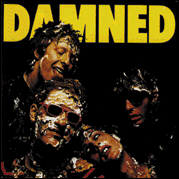
Glance at the artwork for THE DAMNED’s debut, Damned Damned Damned, and you know you’re not about to take a leisurely stroll down “Penny Lane.” Steal a peek at CAPTAIN BEEFHEART’s Trout Mask Replica and you instantly recognize you’re nowhere near MISTER ROGERS’s manicured neighborhood.
These impressions are even more pronounced if you look at a vinyl release’s artwork, where a musician’s image and aura can be larger than life.
Once upon a time, vinyl was synonymous with music. Little did we know that the compact disk would storm onto the scene in the mid-1980s offering convenience and a supposedly more durable product. But some of music’s soul—as well as analog’s continuous transmission of sound—disappeared with the digital revolution.
Gone too was one square foot of artwork on each side of a record. In its place: the CD booklet measuring less than 24 square inches—about a sixth the size of an album.
When the CD was introduced, we learned that we could crack an egg on it, pour the yolk over it, wipe it clean, and then crank it up. Besides being egg-proof, the CD furthered its ‘august heritage’ by having its accompanying artwork (at least that which we could see) encased in fragile plastic, often obscured by promotional stickers that refuse to come off cleanly.
That said, most of my collection is on CD, partly because of its greater availability and partly due to convenience, both from a storage perspective (they’re small and hold loads of music) and because it’s easy to quickly find songs on CD. I also like not having to turn a record over when each side ends. Eggs have nothing to do with it.
But the Internet—once again—changed the equation. Unlike years past when a record or CD’s artwork gave significant clues about the type of music you were about to hear, today we regularly see MP3 files identified by just the artist’s name and a song title.
While there’s been ample hand-wringing about the evolution from vinyl to CD to the MP3, some of the changes are good. When you listen to music with few or no preconceptions, musicians benefit because music is ultimately about sound—not images, beliefs, or morals.

If you loved Trout Mask Replica and wanted to share your appreciation of it with someone who generally dislikes music from the late-Sixties, you’d likely have an uphill climb.
But by blindly playing it to your friend, he would have to judge the music on its own merits with no preconceptions. He couldn’t apply stereotypes based on how the musicians or the artwork looked or when the album was recorded.
I’m aware this cuts both ways though. Musical images and icons help attract like-minded people just as they tell certain people, in short order, to scram—and that’s a good thing too.
Image, the cult of personality, and other intangibles associated with musicians matter significantly—especially in live performance. And I’ll admit that I am guilty of favoring certain musicians for intangibles that extend beyond the music they create.
Everything apart from the music can help inform and contextualize it, but added context, while giving you a truer understanding of what the artist meant to convey and why she did so, should not be a prerequisite or the main reason you appreciate it.
Just as literature is ultimately judged by the words that appear on paper, musicians should be primarily be judged by the sounds they create rather than the boasting, back stabbing, and complaining that all too often make headlines.